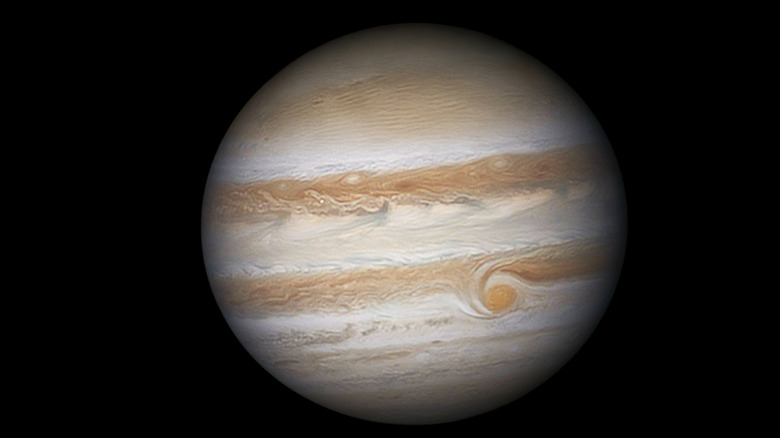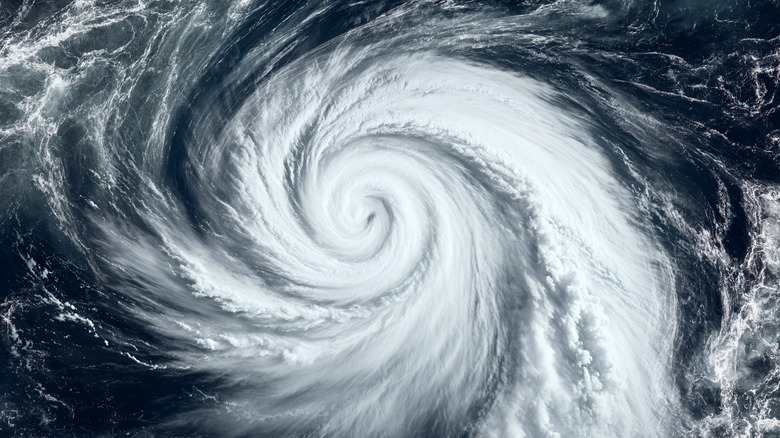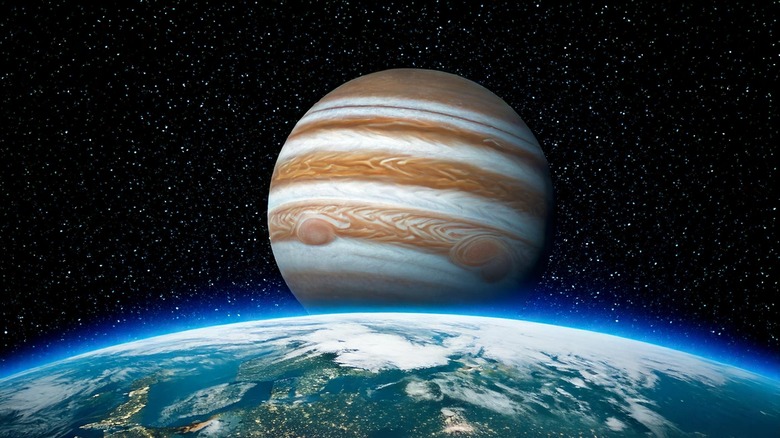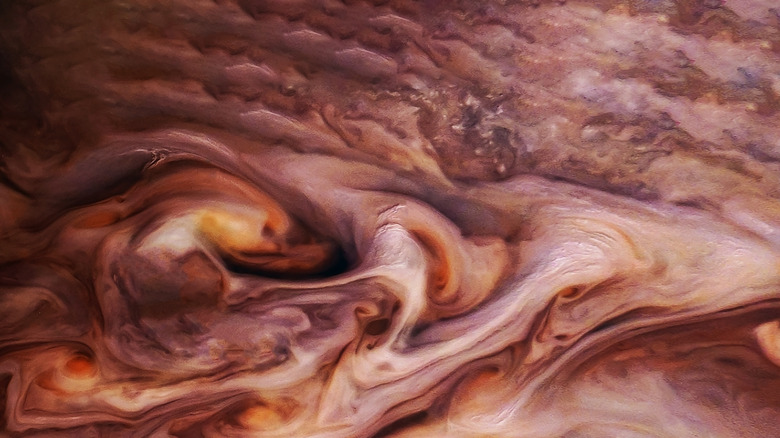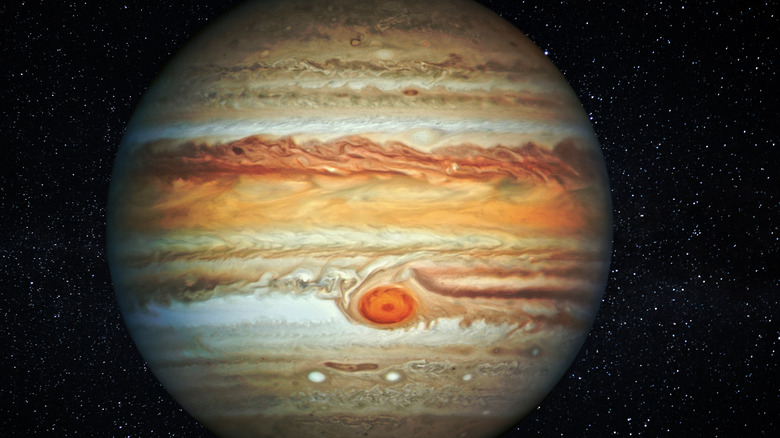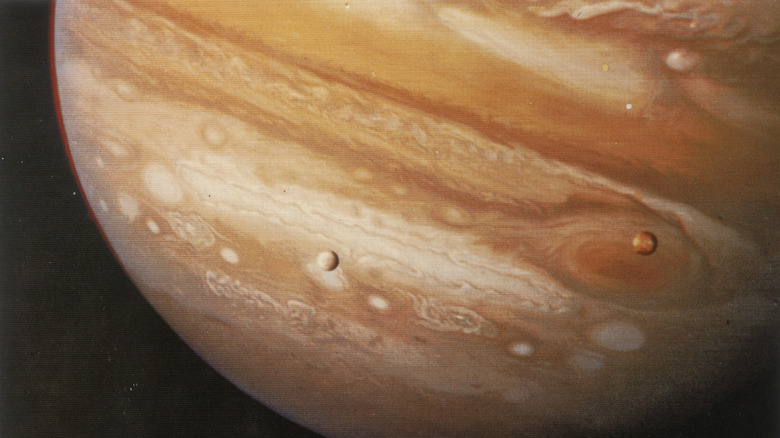The Great Red Spot: 7 Strange Facts About Jupiter's 190-Year Old Storm
Jupiter's Great Red Spot is one of the most recognizable features of our solar system; it's famously larger than Earth itself serves as an identifying mark on the largest of our gas giants. Consisting of a colossal storm that has been raging for centuries, the spot was first officially (and reliably) observed in 1878, and as astronomical technology develops, astrophysicists are learning more about this phenomenon, as well as what gives it the distinctive features that have fascinated scientists throughout history.
From measuring its wind speeds to figuring out exactly why it's red, the two Voyager missions in the late 1970s, the Cassini mission in 2000, and the impressive advantages conferred by the Hubble Space Telescope have been instrumental in determining the most important facts about the enormous storm. Now thought to be ever-changing, there is still plenty more to be revealed about one of our solar system's most extraordinary features. Whether you are a serious amateur astronomer or just love a fun space fact, let's take a look at these seven strange facts about Jupiter's Great Red Spot.
Its wind speeds are changing
Jupiter's Great Red Spot is the biggest permanent storm in our solar system, and it has been raging for at least the last 200 years. It is known as an anti-cyclonic storm, which means that it spins in the opposite direction compared to the kinds of cyclones that you may be familiar with on Earth. The reversed direction is caused by particularly high-pressure zones, which force the air outward.
On Earth, hurricanes are grouped into different categories based on their power, and a hurricane-force wind is considered anything above 74 miles per hour in the lowest category, and 157 miles per hour for the highest, most deadly version. In comparison, the winds involved in the Great Red Spot are consistently blowing at a ferocious 400 miles per hour, based on the measurements that have been taken using the Hubble Telescope.
Recently, though, researchers using the data from Hubble have deduced that the winds are actually speeding up over time, particularly those on the outer edge of the storm. In fact, the inner section may even be slowing, suggesting that it might be surprisingly similar to Earth storms in that it has a calmer "eye" in comparison to the raging outer section. These changes are difficult to monitor, however, and researchers needed to examine data from across the last decade in order to see the subtle changes to the speed of the great storm and predict how it could change going forward.
It appears red due to sunlight hitting gases in the upper layers
Most of us are familiar with Jupiter's Great Red Spot — both on sight and in name — but why is it red in the first place? There are a few theories as to what is causing the unusual color, but recent findings favor one theory over the others. The most likely reason is that the outer layers of the storm appear red due to the sunlight that penetrates them, and that underneath that outer layer, it may not be red at all.
In 2014, researchers tested the effect of sunlight on two of the gases known to be present on Jupiter — ammonia and acetylene — and observed that the result was a reddish glow. This means that sunlight scattering as it enters the gaseous layers of the Great Red Spot is the most likely reason for its distinctive color. These results also suggest that below its bright red exterior, the color of the spot may be much more neutral. "Our models suggest most of the Great Red Spot is actually pretty bland in color, beneath the upper cloud layer of reddish material," said Kevin Baines, a Cassini team scientist (via NASA). "Under the reddish 'sunburn' the clouds are probably whitish or grayish."
Though this explanation is relatively new, scientists have spent a while speculating on the reason the Great Red Spot is, well, red. Previously, it was assumed that the entirety of the Great Red Spot was red, and one theory was that the sun was decomposing ammonium hydrosulfide, which is known to exist in the clouds of the planet. However, in the lab, researchers discovered that this process resulted in a green color rather than red, meaning they had to go looking in other areas.
It was previously three times the width of Earth, but it's shrinking
One of the fun facts you may have learned as a space-obsessed child was that Earth could fit inside Jupiter's Great Red Spot more than twice over. But if you were thinking of bringing out this little tidbit to impress your friends nowadays, you may be surprised to learn that it's no longer as accurate as it once was.
The Great Red Spot is shrinking, and it has reduced from its original 19th-century estimate of 25,500 miles across to a tiny 10,250 miles in diameter. Estimates suggest that the width of the spot is reducing by an average of 580 miles per year, according to a wide look at multiple pieces of data: flybys in 1979 by Voyagers 1 and 2, and images taken by the Hubble Telescope in the mid-1990s and 2009. While the reasons for its shrinkage are not confirmed, a recent study suggests that the GRS may have been interacting with smaller storms nearby, contributing to its overall size. Those other storms might be stealing energy away from the GRS, making it appear smaller, though, in contrast, they could also be feeding it; at the moment, astronomers just aren't sure. But since the diameter of the Earth is 7,926 miles across, the GRS is now only a slightly disappointing 1.3 times larger than our entire planet.
It wobbles
Although Jupiter's Great Red Spot has been monitored for more than 150 years, there are still many new properties of the enormous storm coming to light. The power of the Hubble Space Telescope means that it can be watched in much closer detail than ever before, and a new revelation is that it's not nearly as stable as astronomers first thought.
Photographs on NASA's website taken in late 2023 and early 2024 actually suggest that the center of the spot is oscillating, and a NASA article presented by the Hubble Mission Team claims that it appears to be "jiggling like a bowl of gelatin." In discussing this phenomena, researchers referenced the changes in wind speeds, as well as the way the storm reacts to the jet streams surrounding it.
Unfortunately, little is known of this newly discovered behavior, due to technological limitations and unfortunate timing. Further observation may be able to shed light on the reasons behind the wobbling of the storm, though, including deeper insights on how it is connected to other aspects of Jupiter's atmosphere.
It may have been spotted in the 17th century
Jupiter's Great Red Spot is one of the most famous and recognizable features of the solar system, and it has been recorded and monitored since the mid-1880s. However, there is a good chance that it was spotted long before this official record, as early as 1664.
Robert Hooke, an English polymath with a keen interest in astronomy and eventual creator of Hooke's law, and Italian astronomer Giovanni Cassini, both reported observing a spot on the surface of Jupiter. There has been much discussion as to whether either or both of these accounts could be of the same spot that we can still see now, and some believe that Hooke's observations in might have been a shadow of one of Jupiter's many moons instead.
That said, Cassini's descriptions seem to fit more closely with the famous GRS, though the crucial detail missing is its distinctive red color. Whether this is due to the technical limitations of the time — or because it was a different spot lacking in color — is basically impossible to determine now, but the reports from both scientists suggest that the GRS may have been around for a lot longer than the official records show.
It can change its shape and color
Although Jupiter's Great Red Spot is slowly shrinking in terms of its diameter, it is also changing in other ways, including its height and color. According to data from Voyager 1 and Voyager 2, combined with information gathered from the Hubble Telescope, as its diameter slowly decreases, the depth of the spot seems to increase, meaning the clouds on the top are rising upward.
As the spot seems to be increasing in height, its color is also changing from a dark red to a more orange hue, though that actually fits with with the theory of the red color from sunlight penetrating the clouds and interacting with ammonia and acetylene. If the clouds are changing their position, the scattering of the sunlight could result in a different observable shade. The observations over multiple decades are allowing astrophysicists to piece together a bigger picture of the activity and evolution of the GRS, and the ever increasing quality of data might even allow them to predict what may happen to the storm in the future, too.
There is a Red Spot Jr., too, though it used to be white
If you are familiar the sight of Jupiter's legendary Great Red Spot, you may be surprised to find out that it is not the only great red spot on the planet. Since the turn of the century, the Hubble Telescope has captured detailed images of a second, much smaller red spot, known as Red Spot Jr., which was an estimated 2,000 miles away from its more famous counterpart at its closest.
In the late 1990s, the smaller spot formed as a result of the amalgamation of three different storms, but back then, it was known as White Oval BA, as its color hadn't yet changed to match that of the original GRS. The prominence of the lesser red spot, particularly when viewed at near-infrared wavelengths, has led researchers to believe that the storm reaches the upper cloud layers of Jupiter's atmosphere (much like its more famous cousin), and its existence has sparked suggestions that the enormous planet may be experiencing significant climate change.
